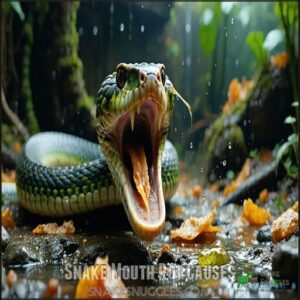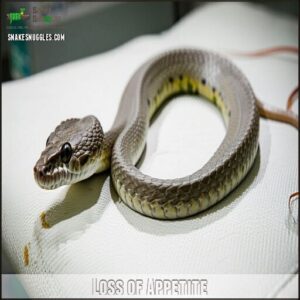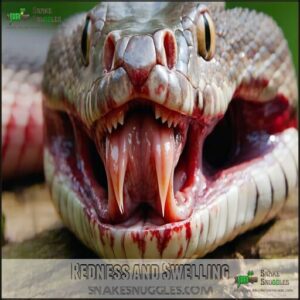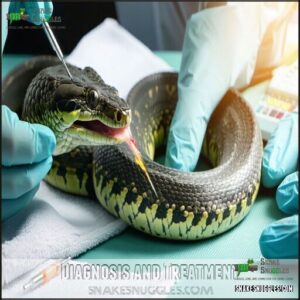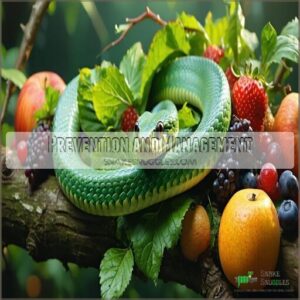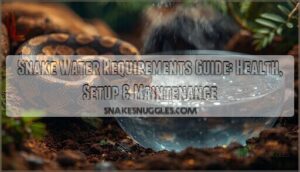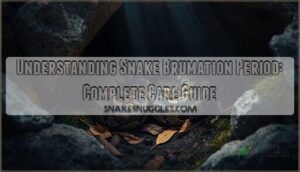This site is supported by our readers. We may earn a commission, at no cost to you, if you purchase through links.

Watch for telltale signs like redness or swelling around the gums and mouth.
Your snake might drool more than usual or refuse to eat its meals—never a good sign.
Look closely for sores, blisters, or even traces of pus or blood.
Sometimes, they’ll breathe with an open mouth or wheeze, which could hint at more serious issues.
Catching these symptoms early makes treatment easier and keeps your scaly friend healthier.
Proper hygiene and a clean enclosure can work wonders in prevention, but there’s more to explore on this topic, including the importance of early treatment.
Table Of Contents
- Key Takeaways
- Snake Mouth Rot Causes
- Early Signs Identified
- Symptoms and Complications
- Diagnosis and Treatment
- Prevention and Management
- Frequently Asked Questions (FAQs)
- Can I treat mouth rot at home?
- How much does it cost to treat mouth rot in snakes?
- How can I spot snake stress indicators?
- What dietary habits reduce infection risks in snakes?
- Can mouth injuries heal without veterinary intervention?
- Are there specific snake species more susceptible?
- What is the role of hydration in healing?
- Conclusion
Key Takeaways
- Watch for early signs like redness, swelling, drooling, or loss of appetite—they suggest potential mouth infections.
- Check your snake’s environment to ensure clean enclosures, fresh water, and proper substrate to prevent bacterial buildup.
- Act quickly if you spot blisters, sores, or wheezing—delayed treatment can worsen the condition and lead to severe complications.
- Routine vet checkups are essential for early detection, accurate diagnosis, and professional care to address any issues effectively.
Snake Mouth Rot Causes
Mouth rot in snakes often starts with bacteria taking advantage of poor conditions or injuries in the mouth.
Bacteria thrive in poor conditions, turning minor mouth injuries into serious infections—early care is your snake’s best defense.
Stress, bad hygiene, and underlying health issues weaken your snake’s immune system, making infections more likely, particularly due to bacteria.
Bacterial Infections
Bacterial infections are the main cause of snake mouth rot, often involving specific bacteria like Pseudomonas or Escherichia coli.
These harmful microbes exploit weakened immunity or injuries, worsening infection severity. Left untreated, they trigger secondary infections and antibiotic resistance.
Spotting early mouth rot signs, like swelling, helps stop snake mouth infections before they escalate. Preventative antibiotics may reduce risks, and understanding the role of bacteria is crucial in managing snake mouth rot.
Poor Hygiene
Poor hygiene in snake care can create a breeding ground for mouth rot. Without proper enclosure cleaning, bacteria buildup can get out of hand.
- Change water daily to prevent contamination.
- Remove waste promptly; fecal removal reduces bacteria.
- Use the right substrate; avoid those that trap bacteria.
Maintaining a clean habitat requires specialized cleaning products. Good snake hygiene starts with a clean environment—your snake will thank you, which is key to preventing bacteria buildup.
Stress and Weakened Immune System
Stress can weaken your snake’s immune system, leaving it vulnerable to mouth rot.
Factors like environmental stressors, nutritional deficiencies, and poor conditions affect snake health.
Overcrowding effects, such as competition for space, also play a role.
Even handling stress builds up over time, compromising resilience.
| Stressors | Effects on Immune System |
|---|---|
| Environmental Stressors | Weakened immunity |
| Nutritional Deficiencies | Increased susceptibility |
| Overcrowding Effects | Stress-induced illness |
| Handling Stress | Compromised snake health |
The impact of these stressors can lead to serious health issues, including weakened immunity and stress-induced illness.
Underlying Health Conditions
Sometimes, a snake’s immune system struggles due to underlying health conditions.
Parasitic infections, viral diseases, or fungal infections often weaken their defenses, making snake mouth rot more likely.
Vitamin deficiencies and even genetic predisposition can play a role too.
Addressing these issues promptly helps reduce stress, strengthen immunity, and prevent complications.
Don’t underestimate how important overall health is for your snake, as it can significantly impact the likelihood of developing snake mouth rot.
Early Signs Identified
Catching snake mouth rot early can make a big difference in your pet’s recovery.
Early detection of snake mouth rot is the key to ensuring a swift recovery and keeping your pet healthy and thriving.
Look out for subtle signs like loss of appetite, drooling, or inflamed gums before the condition worsens.
Loss of Appetite
Loss of appetite is often the first warning sign of snake mouth rot.
If your snake skips meals despite usual food preferences, monitor the refusal duration closely.
Prolonged food avoidance can lead to weight loss and other snake health issues.
Regularly check hydration status and watch for changes.
Avoid force-feeding unless a vet advises, as it risks further harm.
Excessive Salivation
Excessive salivation can be an early sign of snake mouth rot, often stemming from oral discomfort or swallowing issues caused by infection.
You might notice drooling or changes in saliva consistency, which can be dehydrating for your snake. Saliva buildup signals underlying problems like bacterial growth.
Don’t ignore these mouth rot symptoms—seek veterinary advice to prevent more serious complications. This can be caused by inadequate tank cleaning, which is a critical factor in maintaining your snake’s health and preventing serious complications.
Redness and Swelling
Redness and swelling around your snake’s mouth are two early signs of snake mouth rot.
Gum inflammation may make eating uncomfortable, while swelling often signals tissue damage.
Left unchecked, this can lead to facial distortion and oral discomfort, indicating infection severity.
Keep an eye out for these changes to catch snake mouth inflammation early and prevent further complications.
Blisters and Sores
Blisters and sores often appear around the gums or lips and are clear early signs of snake mouth rot.
Pay attention to blister location and sore severity, as these can indicate infection risk.
Without treatment, they may slow the healing process and leave permanent scarring.
Identifying these mouth rot symptoms early helps prevent further damage and guarantees your snake’s recovery.
Symptoms and Complications
You’ll notice symptoms like facial swelling, loss of appetite, or even drooling when mouth rot starts to take hold.
If left untreated, it can lead to serious complications like tooth loss, pus buildup, and breathing trouble.
Facial Asymmetry
When dealing with snake diseases, facial asymmetry should catch your eye. Swelling location may differ, but uneven jaw alignment or muscle atrophy hints at infection severity.
Watch for deformity causes linked to snake mouth rot symptoms, such as bacterial damage.
- Key signs: One-sided swelling or drooping.
- Underlying issues: Inflammation around the jaw.
- Concerns: Difficulty closing the mouth.
- Next steps: Seek immediate veterinary care.
Difficulty Eating
Difficulty eating is one of the early signs of snake mouth rot.
Swelling and pain can cause swallowing issues, leading to weight loss and changes in prey preference.
Food size can worsen discomfort, increasing the regurgitation risk.
Watch for signs like loss of appetite and poor nutritional impact.
One key indicator of illness is lethargy and anorexia.
Addressing this promptly guarantees your snake avoids further complications.
Tooth Loss and Pus Discharge
As mouth rot worsens, tooth loss and pus discharge often occur.
A cottage cheese-like substance, sometimes tinged with blood, signals infection severity.
You may notice:
- Dental abscesses causing tissue necrosis.
- A foul odor from snake mouth pus indicating advanced mouth rot symptoms.
- Teeth loosening and falling out as bone involvement progresses.
- Inflammation damaging gums and jaws.
Immediate care prevents further damage.
Respiratory Distress
Respiratory distress in snake mouth rot can escalate quickly. Watch for labored breathing, open-mouth breathing, or nasal discharge—early signs pointing to worsening systemic infection.
Untreated, it may lead to pneumonia risks.
| Symptom | What It Looks Like | Possible Cause | Action |
|---|---|---|---|
| Open-mouth Breathing | Constantly gaping mouth | Swollen tissues | Seek veterinary care immediately |
| Labored Breathing | Visible chest strain | Inflammation or infection | Provide a clean, warm environment |
| Nasal Discharge | Mucus from nostrils | Bacterial buildup | Clean nostrils gently, consult a vet |
| Pneumonia Risk | Persistent breathing issues | Infection spread | Antibiotics under vet supervision |
Diagnosis and Treatment
You’ll need to act quickly once you spot the early signs of mouth rot in your snake, as prompt veterinary examination and proper treatment are essential for recovery.
Your veterinarian will examine your pet, possibly take samples for testing, and recommend a treatment plan that typically includes antibiotics, mouth cleaning, and addressing the underlying causes.
Veterinary Examination
At the first sign of mouth rot, getting your snake to a reptile vet care specialist is essential.
During the veterinary examination, the vet will gently open your snake’s mouth using a plastic spatula for a thorough physical inspection.
- Detailed health history review to identify potential underlying causes
- Complete examination of oral tissues for inflammation, ulcers, and discharge
- Sample collection through gentle swabbing of affected areas
- Assessment of head carriage and overall body condition
- Visual inspection of nostrils and eyes for related symptoms to check for any related symptoms and ensure the snake’s overall body condition is stable, which can help identify underlying causes.
Laboratory Analysis
After a thorough exam, your vet will likely perform laboratory analysis to pinpoint exactly what’s causing your snake’s mouth rot. This critical step guarantees the right treatment approach.
Here’s what the lab work might include:
| Test Type | Purpose | Common Findings |
|---|---|---|
| Swab Culture | Bacterial/fungal identification | Pseudomonas, E. coli |
| Cytology Methods | Cell examination | Inflammatory cells, organisms |
| Blood Work | Assess systemic impact | Elevated white cell count |
These tests guide your vet toward the most effective treatment plan to address the systemic impact.
Antibiotic Therapy
Once a bacterial infection is confirmed, antibiotic therapy becomes your snake’s lifeline.
Treatment options include silver sulfadiazine cream for topical application, or oral and injectable antibiotics for systemic infections.
Your vet might need to submit a bacterial culture to determine effective medication, as reptile bacteria often show antibiotic resistance.
For severe cases, Ceftazidime can be effective.
Dosage calculation depends on your snake’s size, while treatment duration may extend from weeks to months in severe cases.
Supportive Care
Beyond antibiotics, your snake will need thorough supportive care.
Fluid therapy keeps them hydrated while nutritional support, such as assisted feeding, maintains strength during recovery.
Pain management medications help your pet stay comfortable.
Heat support at proper temperatures boosts their immune response.
In severe cases, hospitalization allows for intensive monitoring and treatment.
Proper hydration requires specialized fluid products.
Remember, these supportive measures work alongside antibiotic therapy to give your snake the best chance at recovery with the help of proper hydration and intensive monitoring.
Prevention and Management
You’ll save yourself countless vet bills and your snake from suffering by maintaining proper hygiene, offering balanced nutrition, and scheduling regular check-ups.
Keeping your snake’s enclosure clean, monitoring temperature and humidity levels, and promptly addressing any health concerns will substantially reduce the risk of mouth rot developing.
Proper Hygiene
Now that you’ve learned about treatment options, keeping your snake’s environment clean is your best defense against mouth rot. Proper hygiene prevents bacterial growth and reduces infection risk.
Enclosure size and design should allow for natural movements and growth, but also consider proper enclosure ventilation to prevent respiratory issues.
Follow these simple steps:
- Clean enclosures weekly, removing waste and sanitizing surfaces
- Change water daily and disinfect bowls to prevent bacterial buildup
- Choose appropriate substrate that won’t harbor moisture or bacteria
Always wash your hands before handling your snake to minimize introducing harmful pathogens and ensure proper hygiene is maintained, which is crucial for preventing bacterial growth and reducing infection risk.
Balanced Diet
Feeding your snake a balanced diet prevents nutritional deficiencies that can lead to mouth rot symptoms.
Offer prey variety by rotating between appropriate food items for your snake’s species. Maintain a consistent feeding schedule—younger snakes need more frequent meals than adults.
Vitamin A deficiency particularly weakens immune systems, making snakes vulnerable to disease symptoms. Consider supplementation options by occasionally dusting prey with calcium and multivitamins.
Providing appropriate snake food is key for their health. Don’t forget hydration importance—always provide fresh water daily.
Regular Veterinary Check-ups
Regular veterinary checkups are essential for snake health and early detection of diseases like mouth rot.
Routine exams provide expert advice and preventative care.
Keep your snake thriving with regular visits:
- Monitor for signs of snake diseases.
- Catch issues before they worsen.
- Get personalized snake care tips.
- Confirm proper husbandry conditions.
- Receive updated health monitoring strategies to help your snake stay healthy and thriving with proper husbandry.
Addressing Underlying Issues
Fixing snake mouth rot starts with tackling stress and nutritional deficiencies.
Adjust your snake’s habitat by focusing on husbandry improvements, like maintaining proper humidity and temperature.
Support their immune system with the right diet and prevent infections by following quarantine protocols for new reptiles.
Addressing underlying health conditions, like parasites or a compromised immune system, guarantees your pet stays healthy and happy with proper husbandry improvements.
Frequently Asked Questions (FAQs)
Can I treat mouth rot at home?
It’s tempting to try, but mouth rot is serious.
While you can improve your snake’s habitat to prevent worsening, treatment needs a vet’s touch.
Home care alone often risks missing critical issues or worsening the infection.
How much does it cost to treat mouth rot in snakes?
Treating snake mouth rot can cost anywhere from $100 to $1,000, depending on severity, veterinary fees, and medications needed.
Early treatment saves money—so don’t wait if you spot symptoms like swelling, redness, or discharge, as it can help prevent further complications and reduce the financial burden of severe treatment.
How can I spot snake stress indicators?
You can spot snake stress by looking for excessive hiding, appetite loss, erratic movements, hissing, or striking.
Watch for unusual behaviors, like constant climbing or rubbing.
These clues often show something’s off in their environment, indicating a need to review their environment and overall care to identify the source of stress.
What dietary habits reduce infection risks in snakes?
Feed your snake a species-appropriate diet, like whole prey items, to meet nutritional needs.
Avoid overfeeding, and make certain food is properly thawed.
Clean up uneaten food quickly to prevent bacterial growth, reducing the risk of infections.
Can mouth injuries heal without veterinary intervention?
Minor mouth injuries in snakes can sometimes heal without a vet if their environment is clean, warm, and stress-free.
However, if you see swelling, pus, or worsening symptoms, don’t wait—seek veterinary care immediately.
Are there specific snake species more susceptible?
Just like how pythons and boas are often poster snakes of captivity, they’re also more likely to get mouth rot.
Their size and husbandry needs mean small mistakes, like poor hygiene or incorrect humidity, hit harder.
What is the role of hydration in healing?
Staying hydrated helps your snake heal by promoting healthy tissue repair and boosting its immune system.
Dehydration slows recovery, so make certain to have access to fresh water and maintain proper enclosure humidity for faster improvement, which is crucial for overall health and recovery.
Conclusion
Why wait for serious symptoms when spotting snake mouth rot early signs can make all the difference?
By monitoring your snake for redness, swelling, or appetite changes, you catch problems before they escalate.
Clean enclosures, proper hygiene, and regular check-ups are key to prevention.
If you notice excessive salivation, blisters, or wheezing, act quickly and consult a vet.
Early action saves your snake discomfort and guarantees a healthier, happier life for your scaly companion, which is the ultimate goal of proper hygiene.
- https://www.safarivet.com/care-topics/reptiles-and-amphibians/boa-and-python/
- https://dakotahillsveterinary.com/2013/12/15/mouth-rot-in-reptiles/
- https://www.justanswer.com/pet-reptile/r0fve-believe-snake-may-mouth-rot-ri.html
- https://ocvetmedcenter.com/news/stinky-snake-breath-takes-the-mouth-rot/
- https://www.thebhs.org/publications/the-herpetological-bulletin/issue-number-52-summer-1995/2585-hb052-08/file

